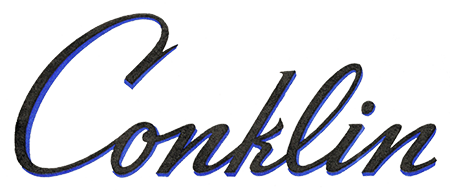Conklin Nozac Chevron 1936–37
by Jim Mamoulides, February 24, 2023
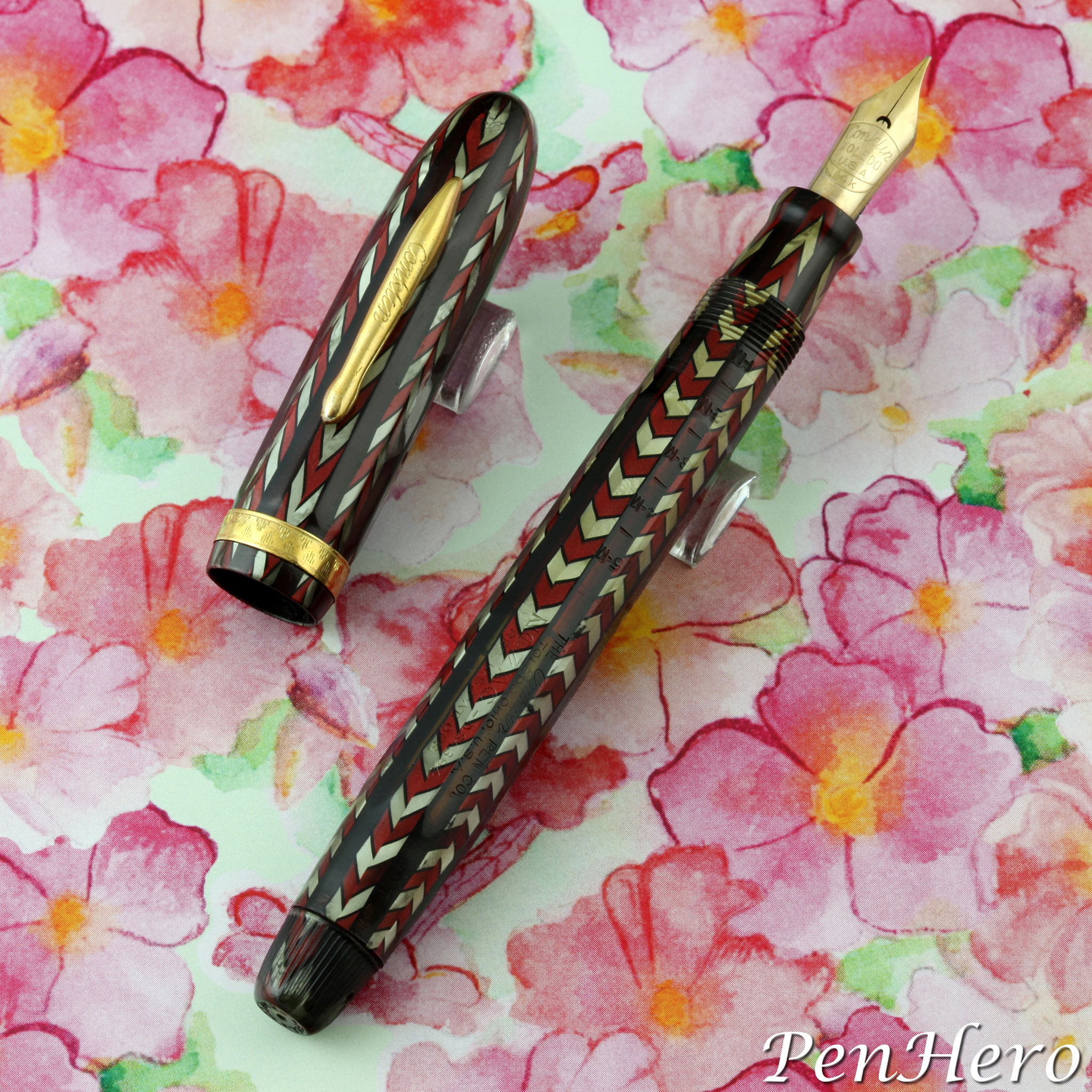 Conklin Nozac Chevron Red Pearl c. 1936
Conklin Nozac Chevron Red Pearl c. 1936
Dialing Up the Chevron
Conklin introduced what many collectors consider the most striking Nozac model, the Chevron, in late 1936. The earliest known Chevron advertisement appears in the Saturday Evening Post September 12, 1936, and describes it as a new model. Often called “herringbone” this stunning design is made from colored celluloid cut and glued into a chevron patterned strip laid out in alternating directions with each separated by thin translucent strips into a sheet and then rolled into tubes for making pens. Andreas Bienenstein, who was awarded the patent for the piston filler system for the Nozac, created and patented six celluloid patterns for the Nozac cap and barrel in 1935. Design patent D096,892 awarded on September 17, 1935, introduced this chevron pattern used on both the Nozac Chevron and V-Line pens.
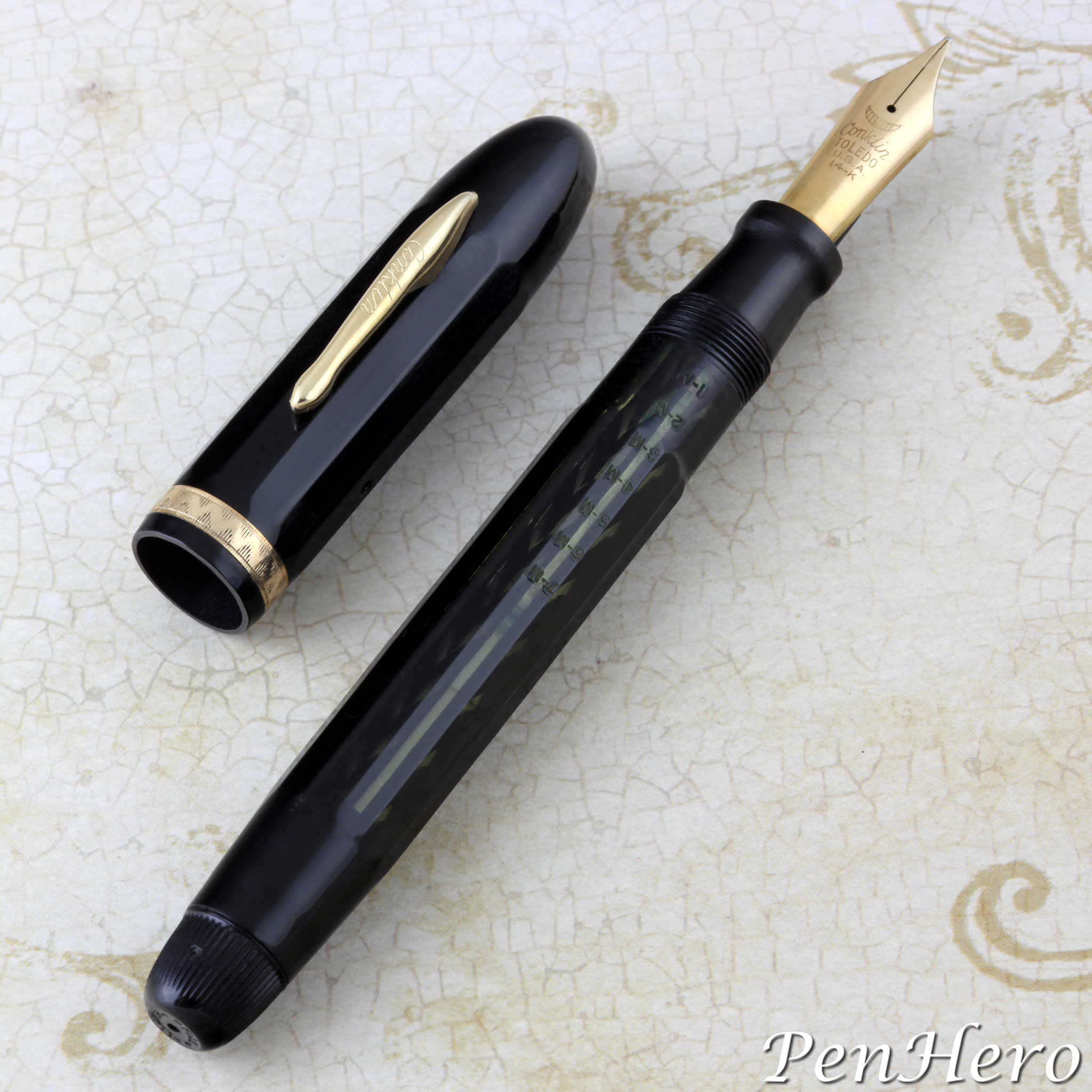 Conklin Nozac Chevron Black c. 1936
Conklin Nozac Chevron Black c. 1936
Chevron Nozacs have a faceted cap and barrel, in either 5M or 7M Word Gauge sizes, with the ‘M’ indicating the number of words in thousands that could be written with the remaining visible ink. Both sizes were the same length, with the larger pen holding more ink. The gauge is stamped on the top portion of the barrel where the translucent celluloid strips provide a window to the remaining ink level. The piston fill mechanism is hidden in the base of the barrel by a black coating on the interior of the barrel. Chevron pens have a single wide cap band with an engraved chevron pattern and feature the newly patented 1936 Conklin clip and the new Cushon Point nib. They were made in black and three striking colors: Red Pearl, Green Pearl and Silver Pearl. The red and silver Red Pearl Chevron is probably the most prized of all Nozacs.
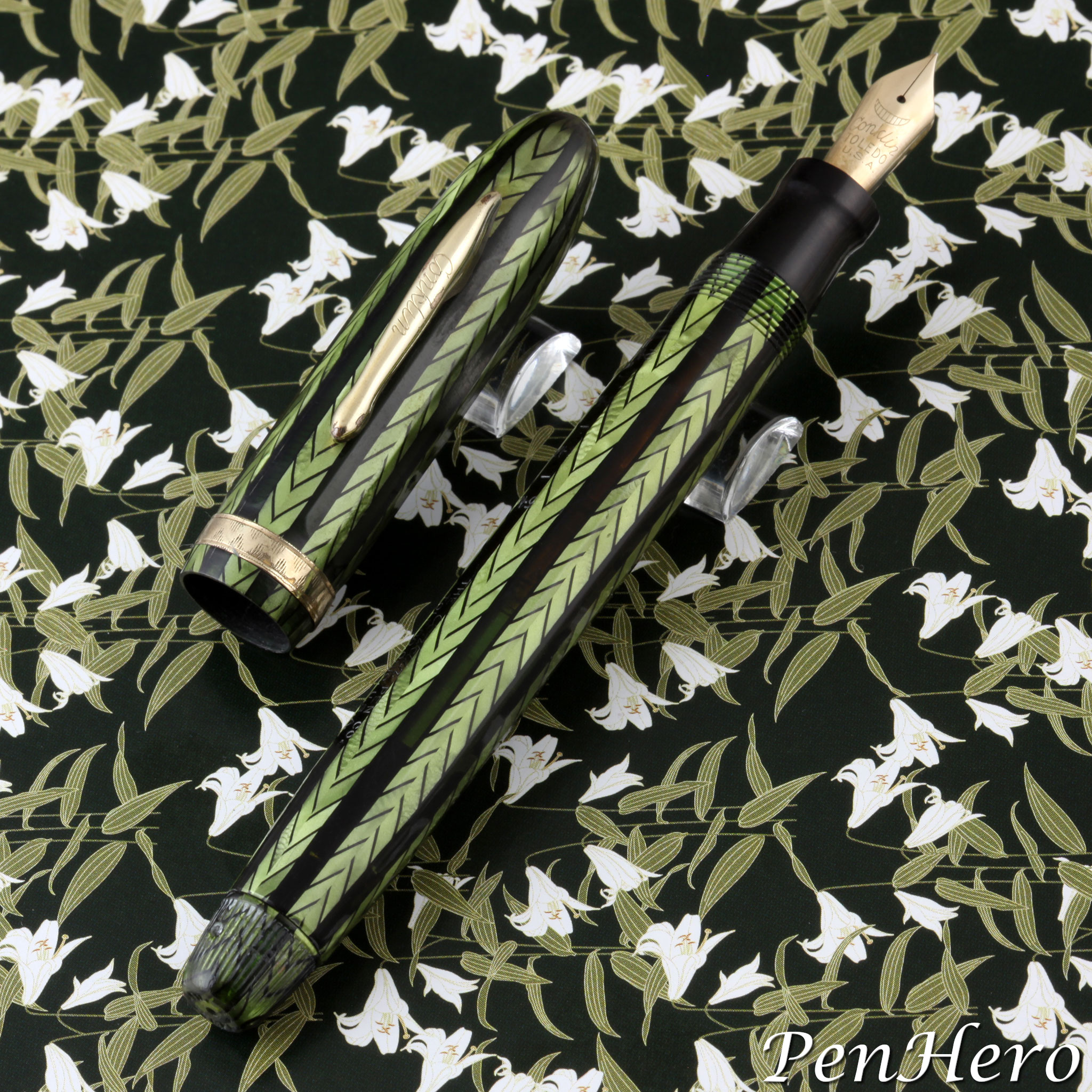 Conklin Nozac Chevron Green Pearl c. 1936
Conklin Nozac Chevron Green Pearl c. 1936
The V-Line, introduced in 1937 and replacing the Chevron line, is a less ornate version, made with a more muted monochromatic chevron celluloid and a plain cap band. The earliest known V-Line advertisement appears in the September 11, 1937, Saturday Evening Post. V-Line and Penline models were shown together in advertisements after the V-Line was introduced, but there are no known advertisements showing either of them alongside the Chevron. As Chevron models do not show in the 1937 catalog, it’s a safe bet that the V-Line replaced the Chevron line. The last known Conklin advertisement specifically featuring the Chevron pens appears in Collier's magazine on November 20, 1937.
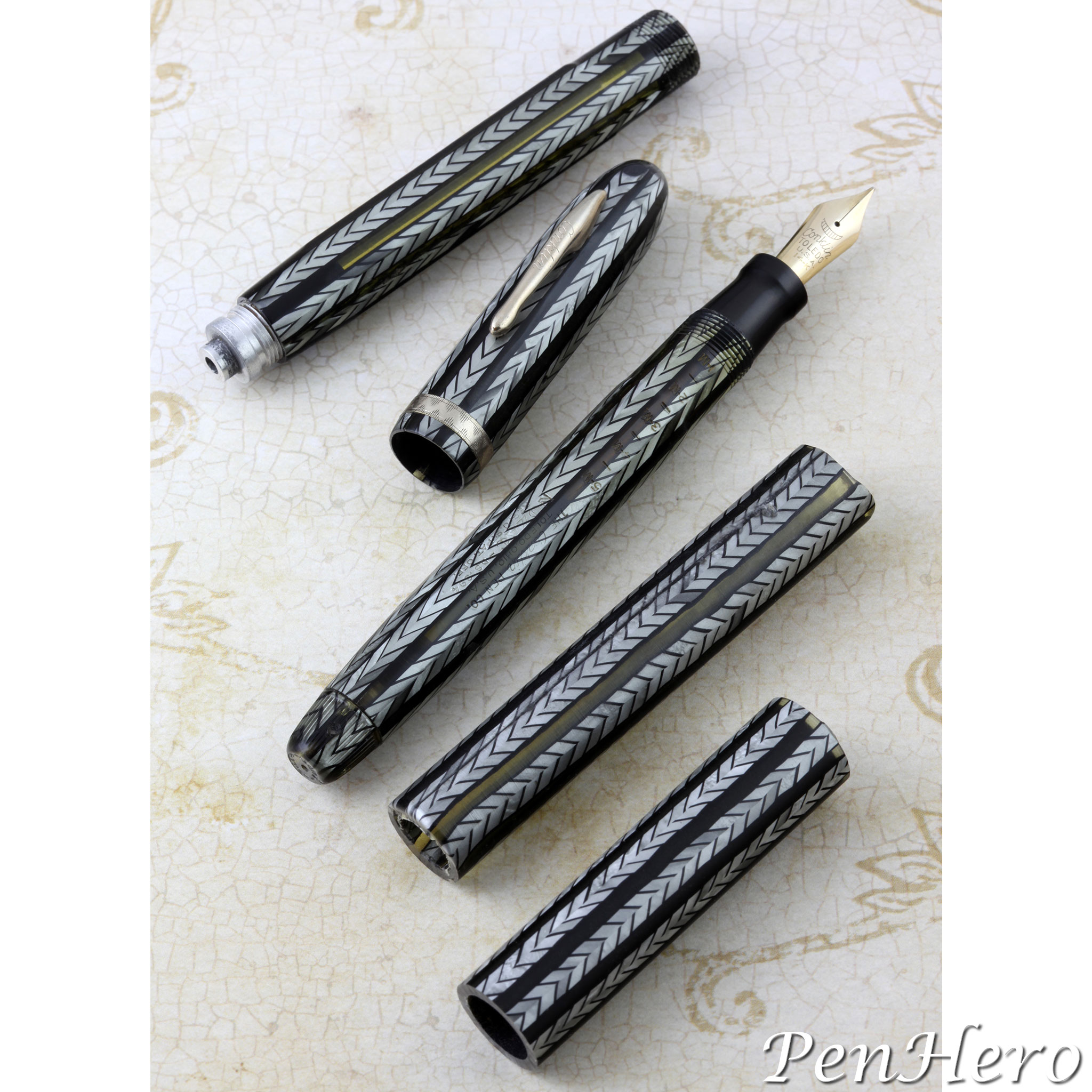 Conklin Nozac Chevron Gray Pearl c. 1936 with parts
Conklin Nozac Chevron Gray Pearl c. 1936 with parts
The Chevron model was short lived, probably made only one year. There is speculation that the pens were expensive to make, and Conklin was evidently having financial troubles at the time of its introduction. Only months after the line was introduced, the company experienced a three week strike of their 115 workers. The pens also may not have sold well. By December 1937, newspaper advertisements appear where Chevron models are offered at deep discounts. Whatever the troubles were, the company was sold to a Chicago syndicate consisting of A. J. Parrson, M. H. Jacobs, and Max Horwitz on July 13, 1938, and its assets were moved to Chicago over the following years.
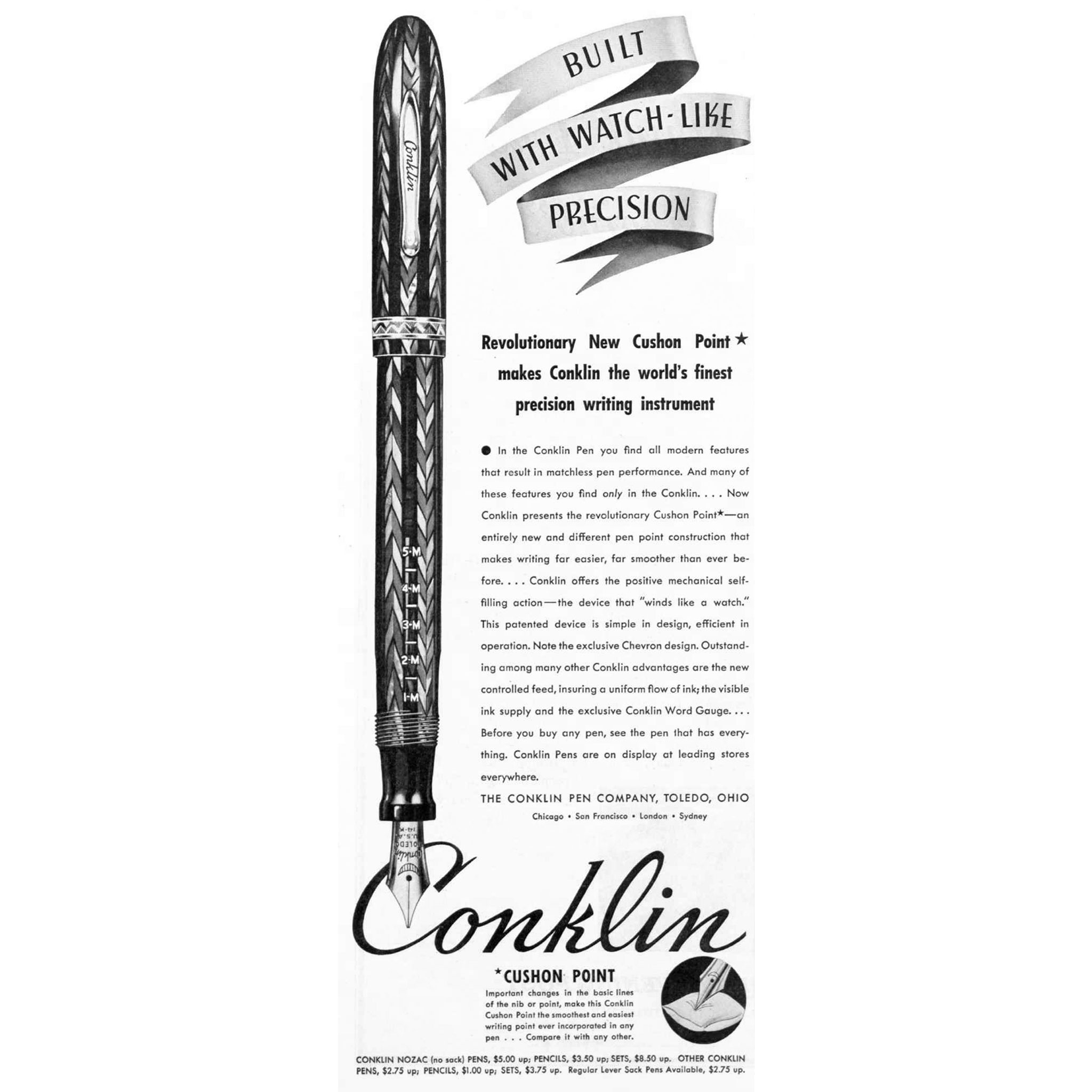 Advertisement in the Saturday Evening Post, September 12, 1936
Advertisement in the Saturday Evening Post, September 12, 1936
Identification Guide and Features
Catalogs and advertisements show Chevron models offered as described in the list below. Conklin clearly made variations, as can be seen when many pens are examined. These may be due to custom orders, production design changes, or pens being made from available parts. The variations include pens found with two-tone platinum or palladium plated gold nibs, nib sections made from matching barrel celluloid, filler knobs made from matching barrel celluloid, and non-advertised cap bands. This list captures what’s common, cataloged, or advertised as Nozacs.
- Faceted celluloid cap and barrel made of chevron strips separated by dark translucent strips. Pattern alternates direction with each stripe
- Colors offered were Black, Red Pearl, Gray Pearl, and Green Pearl
- Two sizes: 14-sided oversize 7,000 word model (about 5 3/8 inches long) and slimmer 12-sided 5,000 word model of the same length
- Gold-filled clip and trim
- Gold-filled clip and trim
- Conklin stamped 1936 patent clip
- Cap unscrews
- Black nib section
- Black or barrel-color piston knob
- 14 karat gold Cushon Point nib with Conklin Crescent logo
- Nib grades offered were extra-fine, fine, medium, coarse, medium stub, broad stub, left oblique, two way, and Recorder in extra-fine, fine, and medium
- 5 3/8 inches long
- Piston-filling mechanism
- 7000 word fountain pens sold for $7.50, 5000 word fountain pens sold for $5.00, and matching twist action pencils were $3.50
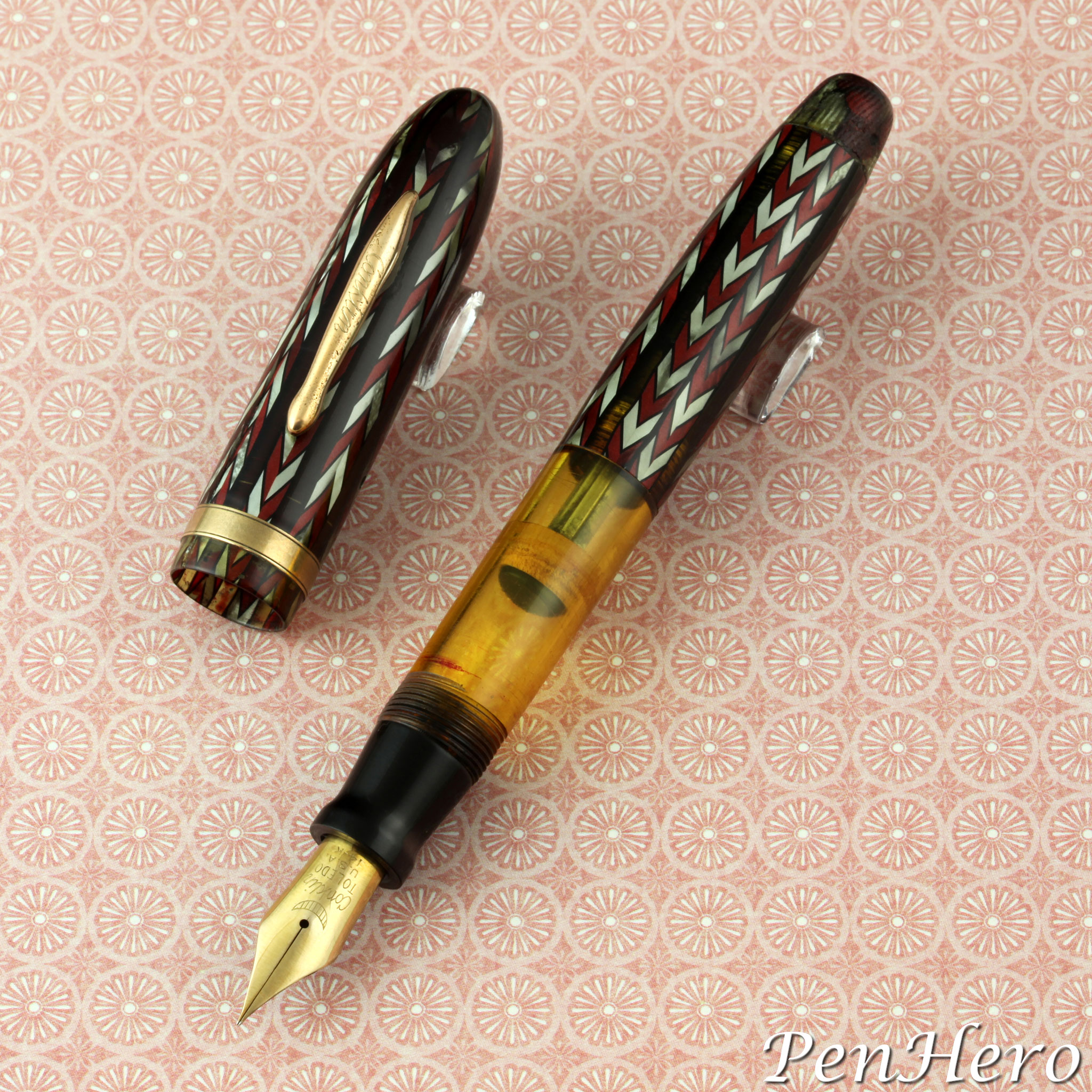 A very unusual Conklin Nozac Chevron Red Pearl with no facets c. 1936
A very unusual Conklin Nozac Chevron Red Pearl with no facets c. 1936
Performance
I remember the first time I saw the Conklin Nozac Chevron Red Pearl on page 53 of Andreas Lambrou’s Fountain Pens of the World. The page shows six Conklin pens, a Green brickwork Penline lever filler, a Pearl and Gold Mosaic lever filler, a Golden brickwork Penline Nozac, a black Chevron Nozac, a Red V-Line Nozac and finally, in the top center a Red Pearl Chevron Nozac. That page became a wish list of pens for many collectors, with the Red Pearl Chevron being at the top of the list. The book was published in 1995 and even in subsequent reprints none of these pens are identified with the correct names and only two have correct dates. I had to go and learn more!
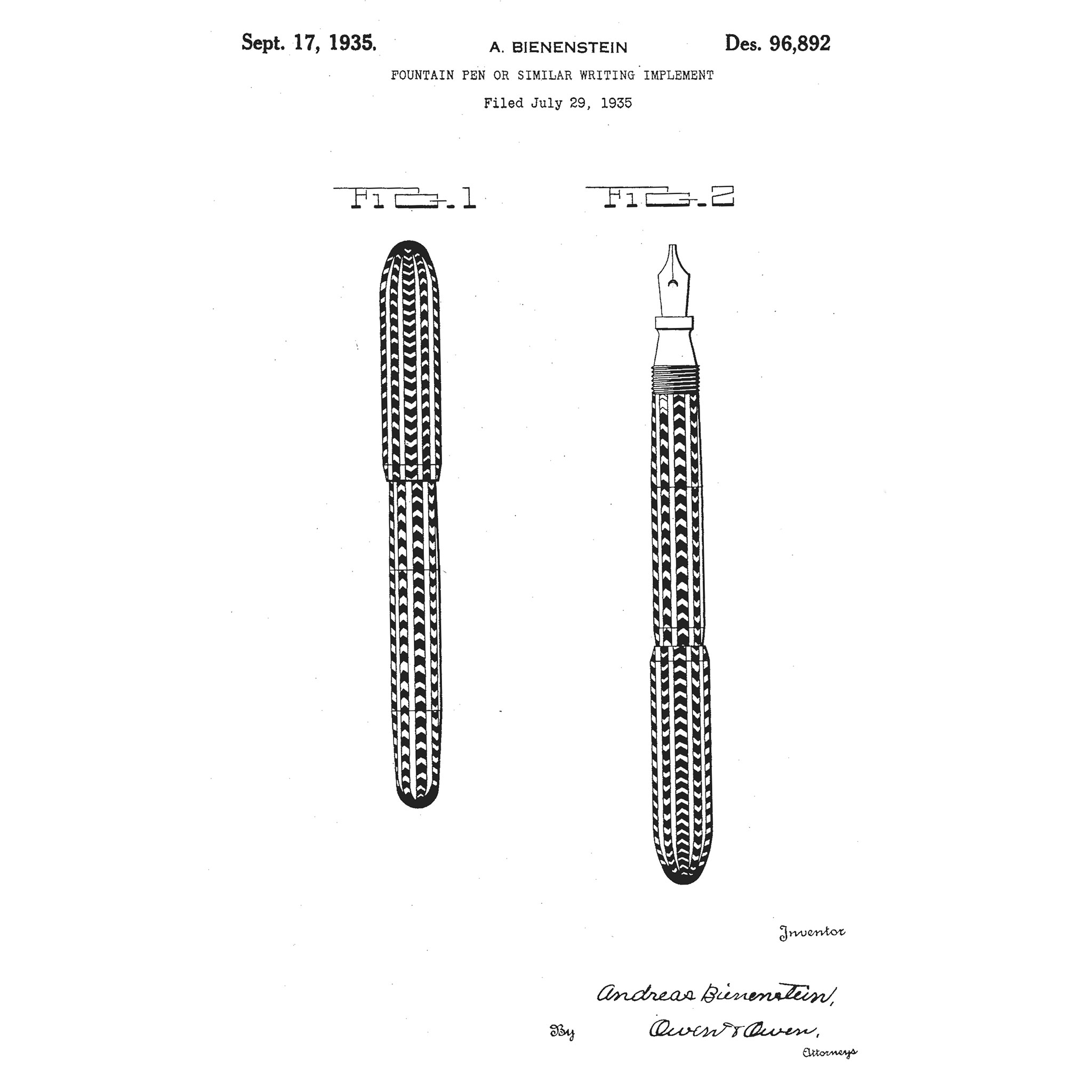 U.S. Design Patent No. D096892 awarded September 17, 1935 to Andreas Bienenstein
U.S. Design Patent No. D096892 awarded September 17, 1935 to Andreas Bienenstein
As with other Nozacs, the Chevron has a visible ink chamber in the top of that barrel that can be viewed through the clear strips of the barrel celluloid. On a working pen the piston mechanism will turn freely and visibly advance and retract, and it will draw water without leaking. All are about 5 1/4 inches long capped and 6 1/8 inches posted. Although the cap will post on the end of the barrel, I don’t think it’s secure enough for vigorous writing and would hate to crack the cap if it fell off. I also don't post these pens to avoid pressing the cap on that could potentially create cap lip cracks. The spring loaded clip works like a clothespin and securely grabs onto even flannel and makes the pen ride high in the pocket.
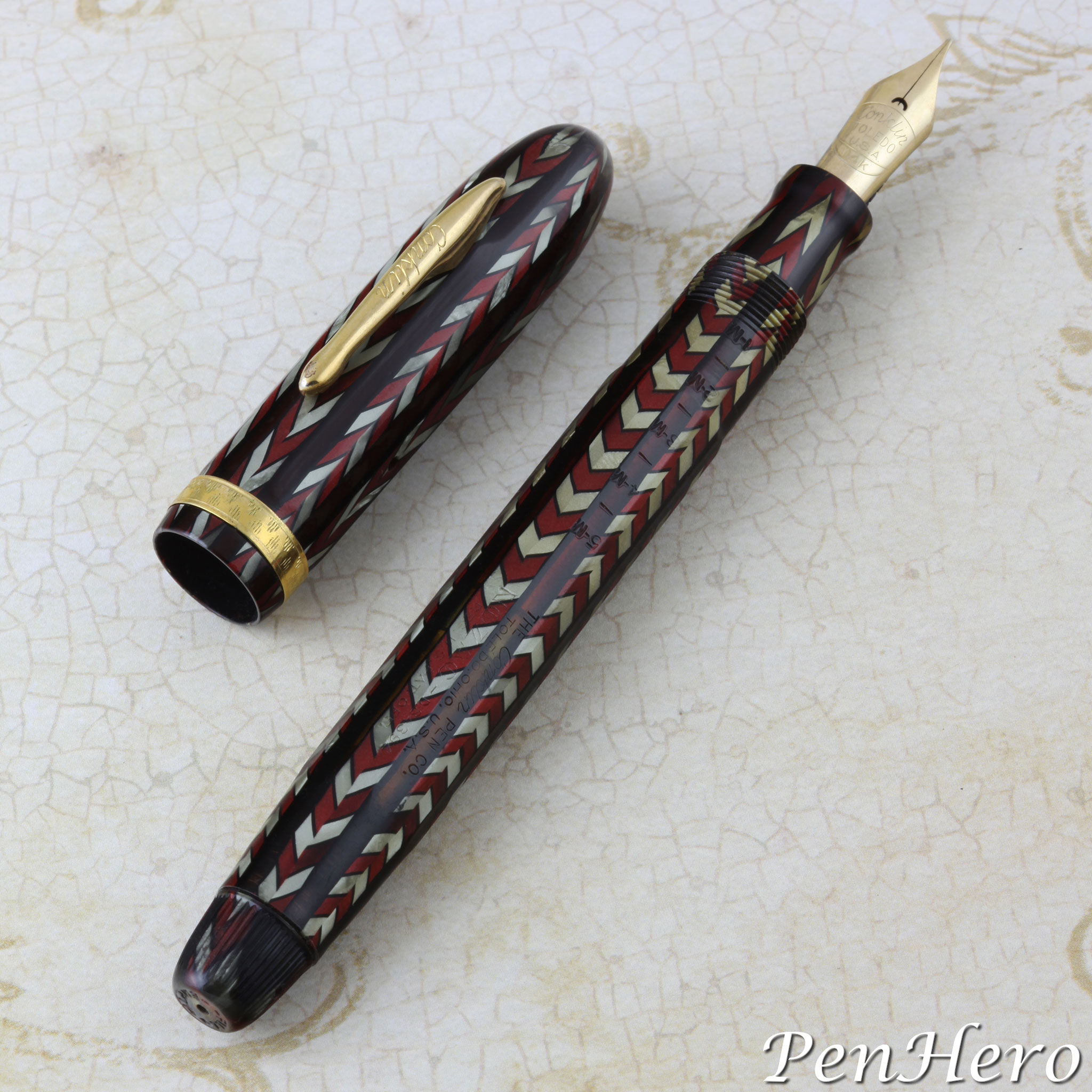 Conklin Nozac Chevron Red Pearl c. 1936
Conklin Nozac Chevron Red Pearl c. 1936
The Nozac fills by twisting the filler knob until the plunger is at the top of the barrel, dunking the nib into the inkwell, and twisting until the pen slowly sucks up the ink. The visible part of the barrel gives a similar view of the ink level as contemporary Sheaffer Vacuum-Fill pens. The Cushon Point nib on the Green Chevron tester I used inks paper on contact with wet, smooth strokes and a little flex. The fit and finish, gold plating and detailing of these pens is first rate. They are fairly light in the hand.
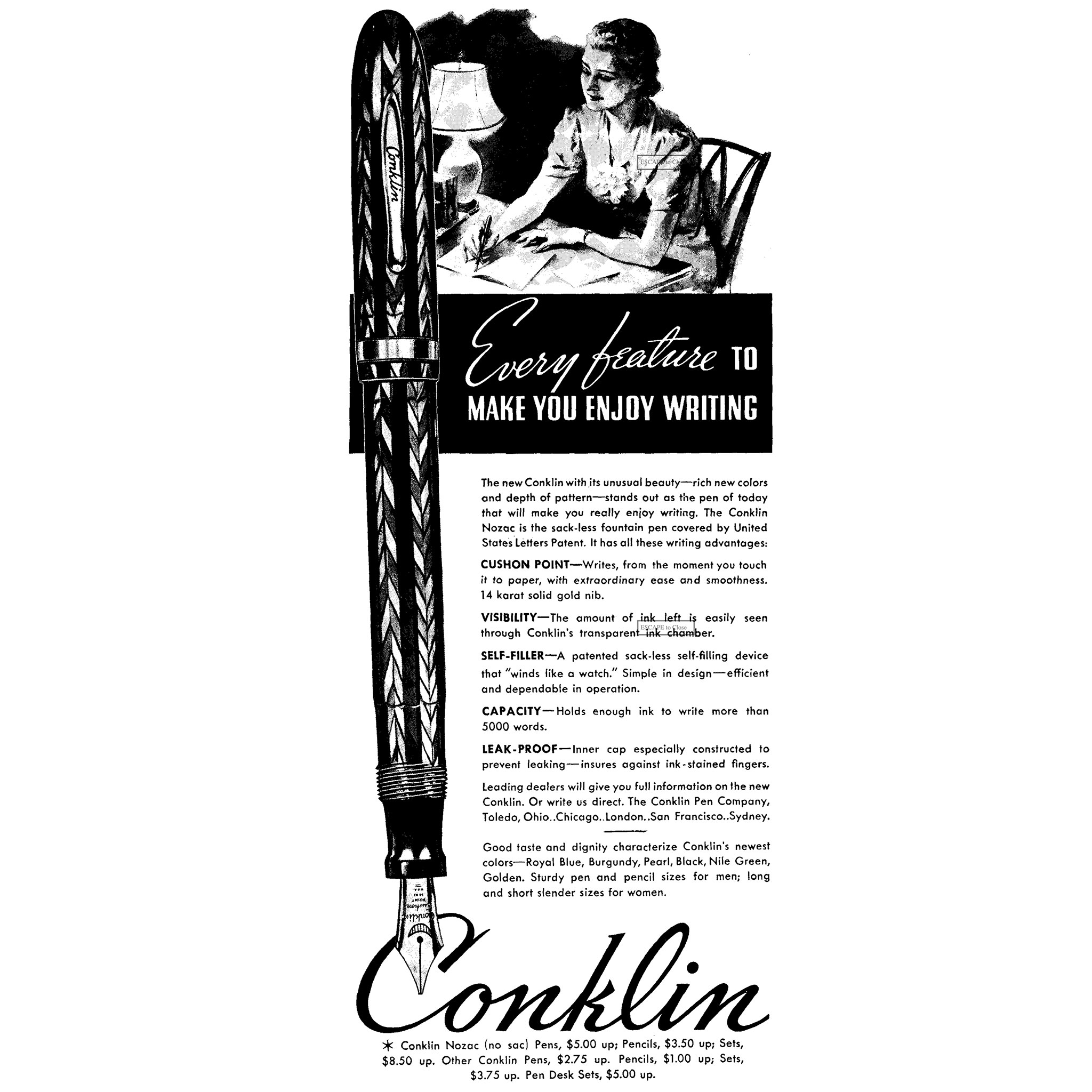 Advertisement in Collier's, November 20, 1937
Advertisement in Collier's, November 20, 1937
Conklin Nozacs can be restored to working condition, but I will say that many are not used as some collectors don’t want to risk discoloring the visible barrel. I would recommend finding a lower grade pen and having it restored if you plan on using it as a writer. A fully restored pen will be more expensive than an unrestored pen of the same model. Beware that some non-working piston fillers may not be restorable and would serve only as parts pens. Key questions for an unrestored Nozac include barrel clarity, if the piston moves up and down easily, if there are any cracks in the cap lip or barrel, and if the clip opens and closes tightly. When in doubt, ask a Conklin Nozac repair person.
If you are looking for your own Chevron Nozac, expect it to be less common and higher priced than other Nozacs and many other pens from the same period. In my experience the black pen is very uncommon, but not the most valuable or sought after. While they can easily be confused with black V-Line pens, the Chevron cap band tells you it’s a Chevron.
To me the Chevron pens stand out in any presentation of Nozacs, especially the Red Pearl and in my experience, they command the highest prices. Pretty amazing for a pen that was on 50% closeout just over a year after being introduced.
Acknowledgements
Many thanks Pete Kirby and Dave Glass for their invaluable help on facts and history of Conklin Nozacs.
Pennant Summer 2019
This story appeared in the summer 2019 Pennant, the magazine of the Pen Collectors of America (PCA). You can learn more about joining the PCA and subscribing to the Pennant by clicking the link.
References
Advertisement in Collier's, November 20, 1937, page 56
Advertisement in the Saturday Evening Post, September 12, 1936, page 104
Cincinnati Enquirer, March 9, 1937, page 2
Cincinnati Enquirer, July 14, 1938, page 16
Conklin 1936 Catalog
Conklin 1937 Catalog
New York Daily News, December 1, 1937, page 9
St. Louis Post Dispatch, February 20, 1937, page 2A
U.S. Design Patent No. D096892 awarded September 17, 1935 to Andreas Bienenstein
Interact
Comments on this article may be sent to the author, Jim Mamoulides


